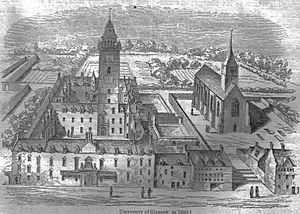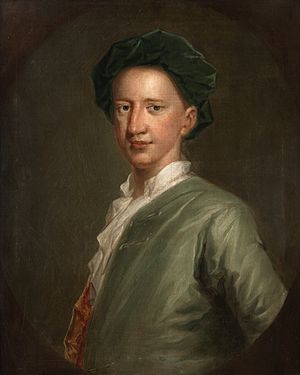Alexander MacFarlane (astronomer) facts for kids
Alexander MacFarlane FRS (c. 1702 – 23 August 1755) was a very smart Scottish person who did many things. He was an astronomer, a merchant, a mathematician, a judge, and a politician. He was born in Scotland and later moved to the British colony of Jamaica.
In Jamaica, he became a successful merchant. He also owned several large farms where sugar was grown. He used the labor of enslaved people on these farms. Besides his work, MacFarlane loved studying the stars. He built special places called observatories to watch the sky. After he died, his astronomy tools were given to the University of Glasgow. The university used them to start an observatory named after him.
Contents
Early Life and Education

Alexander MacFarlane was born in Scotland around 1702. His father, John MacFarlane, passed away in 1705. His mother was Lady Helen Arbuthnot. Her family's motto meant "the stars my camp, the Lord my light."
Alexander was the youngest of four sons. He went to the University of Glasgow. In 1728, he earned a Master of Arts degree. After finishing his studies, MacFarlane moved to the British colony of Jamaica.
Life and Work in Jamaica
After arriving in Jamaica, Alexander MacFarlane started a career as a merchant. He slowly bought many pieces of land. By 1735, he was a successful trader and an assistant judge. He owned several large sugar cane farms.
In November 1735, he became the first Postmaster General of Jamaica. This meant he was in charge of all the mail services. MacFarlane also became involved in politics. In 1754, he was chosen to represent Saint Elizabeth Parish in the House of Assembly of Jamaica. This was like being a member of parliament.
His Passion for Astronomy
Besides his busy work life, MacFarlane was very interested in astronomy and mathematics. He bought a house in Port Royal and built an observatory there. He bought special astronomy tools from Colin Campbell. Campbell was another farmer and astronomer who knew Sir Edmond Halley.
Campbell had built his own observatory in Jamaica in 1731. He used it to study the stars in the southern sky. By 1743, MacFarlane had bought all of Campbell's astronomy equipment. He then built another observatory in Kingston, Jamaica. This new observatory had several important tools. It had a large arch for measuring stars and a special telescope. It also had a very accurate clock and another telescope for looking straight up.
MacFarlane found one of his telescopes hard to use. So, he designed a new type of telescope. In 1755, he hired Pierre Martel, a Swiss instrument maker, to build it. Martel also helped take care of MacFarlane's other equipment.
Joining the Royal Society
In November 1743, MacFarlane wrote a letter to James Short. Short was a Scottish telescope designer. MacFarlane shared his observations from Jamaica. Short then traveled to London and read the letter to the Royal Society. The Royal Society is a famous group of scientists. Short suggested that MacFarlane should become a member.
Even though his astronomy work was not huge by today's standards, MacFarlane was made a member of the Royal Society. This happened on November 20, 1746. He continued to send his observations to the Royal Society until he passed away. Alexander MacFarlane died on August 23, 1755. At the time of his death, he owned many sugar farms. He also owned 791 enslaved people who were forced to work on these farms.
His Legacy
After Alexander MacFarlane died, his observatory in Kingston was turned into a jail. MacFarlane never married, so he left most of his property to his two brothers, Walter and William. This included his six sugar farms.
His will also said that all his astronomy tools should be given to the University of Glasgow. The equipment was shipped from Jamaica to Scotland. It got a little damaged on the journey because of the ocean air. The university received the tools on October 29, 1756. They hired James Watt to fix them. The next year, the university opened an observatory using MacFarlane's instruments. They named it Macfarlane Observatory in his honor.
In recent years, people have looked more closely at MacFarlane's ownership of enslaved people. In 2018, the University of Glasgow published a report. It was part of their effort to understand their past connections to slavery. The report noted that MacFarlane became very wealthy because he owned enslaved people. It also pointed out that while his instruments were important for the observatory, he did not give any money to the university in his will.
Images for kids




